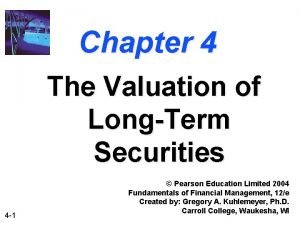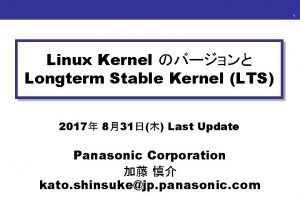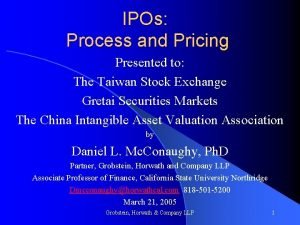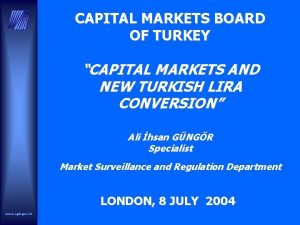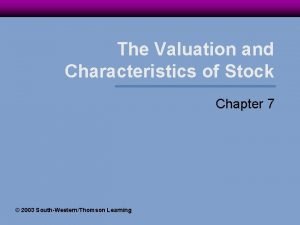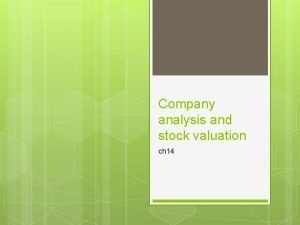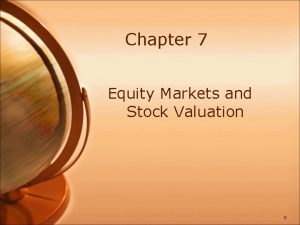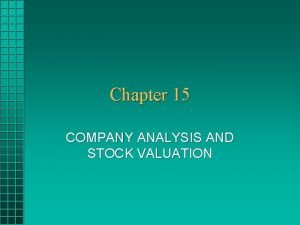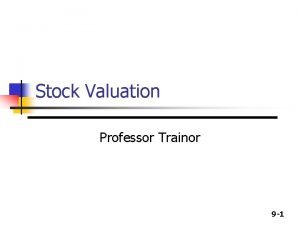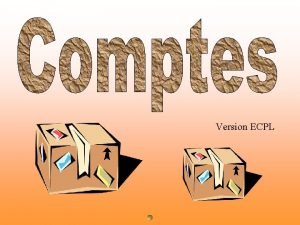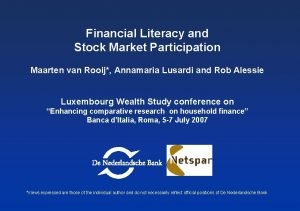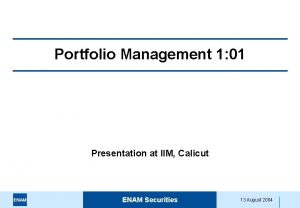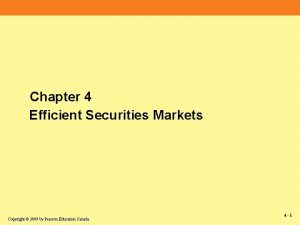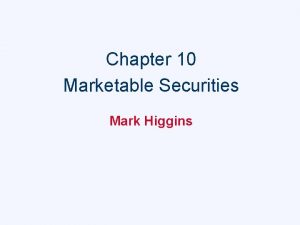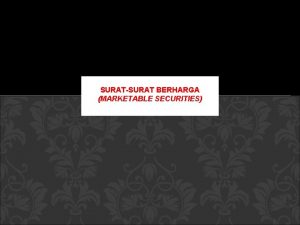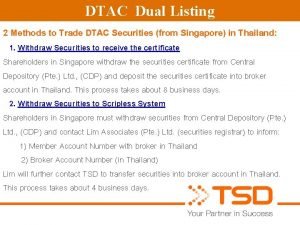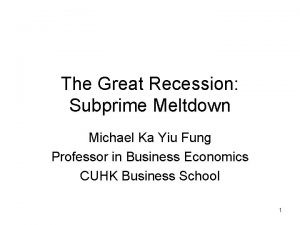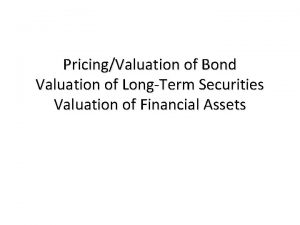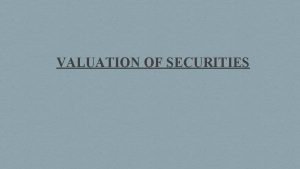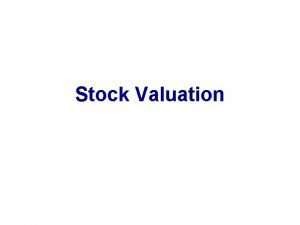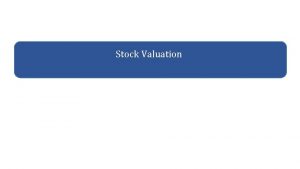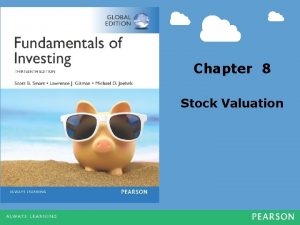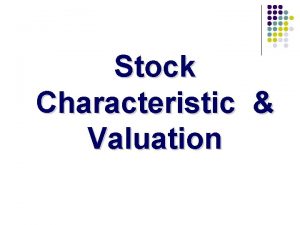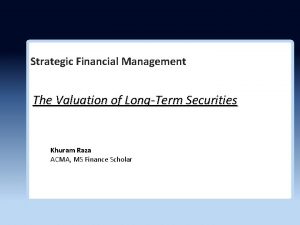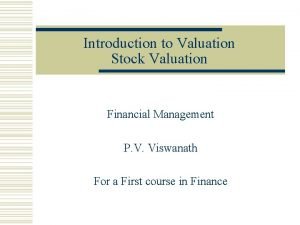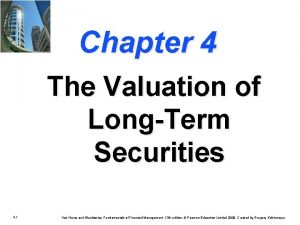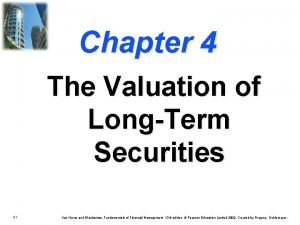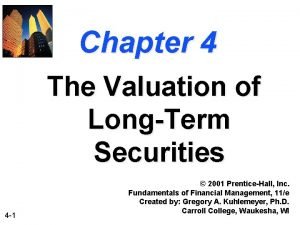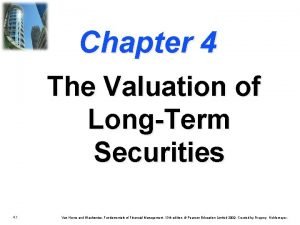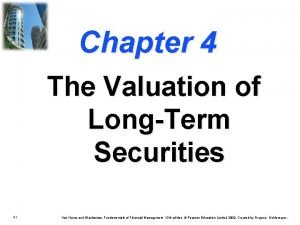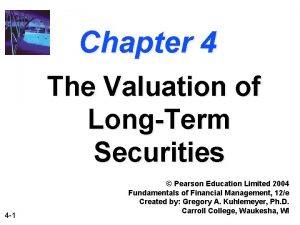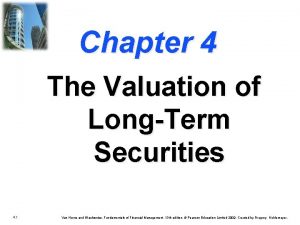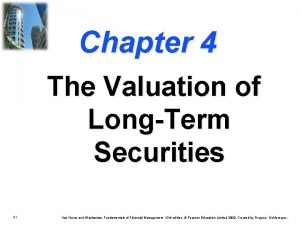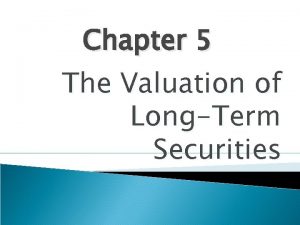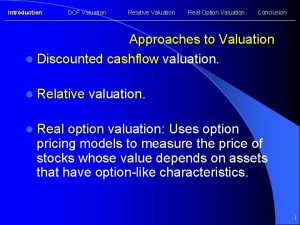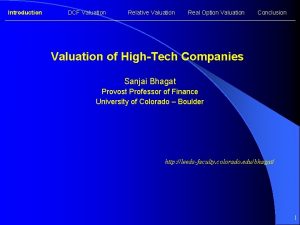Stock PricingValuation of LongTerm Securities Valuation of Financial































- Slides: 31

Stock Pricing/Valuation of Long-Term Securities Valuation of Financial Assets

• Equity Financing – Equity financing is the sale of ownership of he company for fund raising • Stock – Stock is the instrument of fund raising and it’s the claim of owners financial asset on the real assets of the company without any promised of dividend

• Stock is arguable than there will be subjectivity. If it subjectivity there will be variation and higher will be uncertainty and higher will be risk • Life of company is unlimited then the stock will be unlimited • If company is ongoing concern then stock will be ongoing concern

Undisputable Bonds Disputable Stocks • Coupon • Face Value • Dividend • Fixed % of Face Value (FV) • Fixed price written on the bond • Not Fixed • Market Price of Share (MPS) • Variation in share price volatility

Pricing of Bond • Pricing – Pricing is the PV of future cash flow discounted at appropriate discount rate • PB = C 1_ _ + C 2_ _ +. . . . + FV__ (1 + kd)1 (1 + kd)2 (1 + kd)t – Bond = kd = Cost of Debt – Stock = ke = Cost of Equity – Loan = i = Cost of Loan

Pricing of Stock • Ps = D 1_ _ + D 2_ _ +. . . (on going stock) (1 + ke)1 (1 + ke)2 Unlimited • Ps = D 1_ _ + D 2_ _ +. . . . + MPS_ _ Limited (1 + ke)1 (1 + ke)2 (1 + ke)t • If resolved at maturity

Types of Stock Irredeemable Redeemable – Ps (Unlimited) – Ps (limited) – Unlimited life of stock like common stock – Company will buy the stock at maturity

Techniques of Pricing/Valuation the Stock • • Relative Models Cash Based Models Dividend Based Models Value Added Models

Relative Models • All information will be taken from market and books a) Price Earning Ratio • P/E = MPS EPS b) Market to Book Ratio • P/BV = MPS___ BV per share

Relative Models c) Sales to Price Ratio • • S/P= Sales per Share MPS If overall = Total Sales_ ___ Market Capitalization=MPS * No. of shares outstanding

Relative Models d) EBIT to Price Ratio • EBIT of per Share MPS e) Cash to Price Ratio • = Cash dividend per share MPS

Cash Based Models a) Free Cash Flow Approach • FCF b) Residual Equity Cash Flow Approach • RECF c) Adjusted Present Value Approach • APV

Dividend Based Models a) No Growth Model b) Constant Growth Model c) Supper Normal Growth Model OR Phased Growth Model OR 2 or 3 Stage Growth Model

Value Added Models a) Economic Value Added • EVA b) Market Value Added • MVA c) Cash Value Added • CVA

Relative Model • Price Earning Ratio Company MPS EPS P/E Fair MPS Decision A 40 20 40/20= 2 1. 65*20= 33 Overvalued Sell B 10 8 10/8= 1. 25 1. 65*8= 13. 2 Undervalued Buy C 100 60 100/60= 1. 67 1. 65*60= 99 Overvalued Sell D 5 3 5/3= 1. 67 Overvalued Sell • P/E= MPS EPS 1. 65*3= 4. 95

Relative Model • Price Earning Ratio • (P/E) of Industry = S (P/E) _ =1. 65 No. of Companies = 6. 59 4 – If there is variation/subjectivity than there will be difference in between the actual and estimated/ fair price • Fair MPS = (P/E) of Industry * EPS • Overvalued IF fair price is less than the MPS • Undervalued IF fair price is greater than the MPS

Relative Model • Sales to Price Ratio Company Total Sale No. of MPS Shares Sales per Share S/P Fair MPS Decision 1 10000 50 40 10000/50 = 200/40 = 5 200/17. 8 Overvalued = 11. 23 Sell 2 5000 20 30 5000/20= 250/30 = 8. 3 250/17. 8 Overvalued = 14. 04 Sell 3 8000 10 20 8000/10= 800/20 = 40 800/17. 8 Undervalued Buy = 44. 94

Relative Model • Sales to Price Ratio • • • S/P= Sales per Share MPS Sales per Share = Total Sales _ No. of Shares When same market is efficient (S/P) of Industry = S (S/P) _ = 53. 3 No. of Companies 3 Fair MPS = Sales per Share_ (S/P) of Industry =17. 8

Free Cash Flow • Cash flows which are available to distribute between bond holder (debt provider) and share holder (equity provider) after fulfilling the business requirement • Requirement a) b) c) d) Operating Expenses/CGS Tax Working Capital Expenditure (Investment in Fixed Asset)

Free Cash Flow • FCF = EBIT (1 -Tax) + Depreciation + NWC + Capital Expenditure • • • EBIT = Earning Before Interest & Tax NWC = Change In Net Working Capital NWC = Net Working Capital WC = Current Assed (CA) NWC = CA – CL

Free Cash Flow • MPS = VE _ No. Of Shares • VE = Value of Equity • VE = V c – V d • Vc = Value of Company • Vd = Value of Debt

Free Cash Flow • VC = FCF (1+ g. FCF ) WAVV – g. FCF • g. FCF = Growth Rate of FCF • WACC = Weighted Average Cost of Capital • g. FCF (i/r) = (FVFCF/PVFCF) 1/t – 1

Free Cash Flow • WAAC = We. Ke – Wd. Kd (1 - Tax) • • We = Weigh of Equity Ke = Cost of Equity Wd = Weigh of debt Kd = Cost of debt

Free Cash Flow • Ke = Rf + b (Rm - Rf) • Rf = Risk Free Rate (T-Bill Rate) • Rm = Market Risk • b = Systematic Risk

Choice of Growth Rate CAGR • Cumulative Annual Growth Rate • If there is continuous increase pattern in FCF’s/ almost SAGR • Simple Average Growth Rate • If there is trend of increase or decrease • Growth rate will be calculated per year

Question Year EBIT Depreciation Capital Expenditure 2010 500 600 2011 5500 600 2012 6000 500 2013 6000 500 2014 5800 500 2015 7000 500 • • • If NWC is 10% of EBIT and Tax is 30% of EBIT Rf = 5% Kd = 10% Rm = 15% b = 1. 5 % D: E= 40: 60 Wd = 0. 4 g. FCF = 5. 3% Tax = 30% t=5 Value of shares = 1000 FVFCF = 4780 Vd = 2200 We = 0. 6 PVFCF = 3700

Solution Year EBIT Depreciatio n Capital NWC Expenditure NWC 2010 500 600 500 2011 5500 600 550 50 2012 6000 500 600 50 2013 6000 500 600 0 2014 5800 500 580 -20 2015 7000 500 700 120 -- • NWC = Current NWC – Previous NWC • FCF = EBIT (1 -Tax) + Depreciation + NWC + Capital Expenditure

Solution 2010 2011 2012 2013 2014 2015 EBIT 5000 5500 6000 5800 7000 Tax (1500) (1650) (1800) (1740) (2100) Depreciation 500 500 500 -- (50) 0 20 (120) (600) (500) -- 3700 4150 4200 4080 4780 NWC Capital Expenditure FCF • • g. FCF = (FVFCF/PVFCF) 1/t – 1 g. FCF = (4780/3700) 1/5 – 1 g. FCF = 0. 053 g. FCF =5. 3%

Solution • • Ke = Rf + b (Rm - Rf) Ke = 0. 05 + 1. 5(0. 15 – 0. 05) Ke = 0. 2 Ke = 2% • • • WAAC = We. Ke – Wd. Kd (1 - Tax) WAAC = 0. 60 (0. 20) – (0. 40)(0. 10)(1 – 0. 3) WAAC = 0. 12 – 0. 04 (0. 7) WAAC = 0. 092 WAAC = 9. %

Solution • VC = FCF (1+ g. FCF ) WAVV – g. FCF • VC = 4780 (1 + 0. 053) 0. 092 – 0. 053 • VC = 129060 • VE = V c – V d • VE = 129060 – 22000 • VE =107060

Solution • MPS = VE _ No. Of Shares • MPS = 107060 1000 • MPS = 107. 60
 Fixed income securities
Fixed income securities The invoice price of a bond is the ______.
The invoice price of a bond is the ______. Valuation of long term securities
Valuation of long term securities York will end longterm solitary jails
York will end longterm solitary jails Kernel lts
Kernel lts Pricing of securities in stock exchange
Pricing of securities in stock exchange Capital markets board of turkey
Capital markets board of turkey Scope of registered valuer
Scope of registered valuer Characteristics of stock valuation
Characteristics of stock valuation Company analysis stock valuation
Company analysis stock valuation Grade 12 accounting inventory valuation
Grade 12 accounting inventory valuation Avco method of stock valuation
Avco method of stock valuation Equity markets and stock valuation
Equity markets and stock valuation Company analysis and stock valuation
Company analysis and stock valuation Preferred stock valuation
Preferred stock valuation Common stock valuation formula
Common stock valuation formula Stock initial
Stock initial Long-term debt preferred stock and common stock
Long-term debt preferred stock and common stock Stock and sauce
Stock and sauce Characteristics of common stock
Characteristics of common stock Financial literacy and stock market participation
Financial literacy and stock market participation Non financial methods of motivation
Non financial methods of motivation Securities holdings statistics
Securities holdings statistics Understanding securities
Understanding securities Enam securities portfolio
Enam securities portfolio How would you define efficient security markets
How would you define efficient security markets Marketable securities examples
Marketable securities examples Cash and marketable securities management
Cash and marketable securities management What does public issue management mean
What does public issue management mean Lesson 2 roosevelt and taft
Lesson 2 roosevelt and taft Trade securities
Trade securities Mortgage backed securities diagram
Mortgage backed securities diagram


